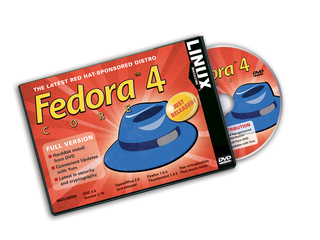
We are proud to bring you Fedora Core 4 on this month's Linux Magazine DVD. Fedora Core 4 is the latest in a line of popular Linux products from Red Hat's Fedora Project. Since the first Fedora release in 2003, Fedora Core has become one of the most influential free versions of Linux. Red Hat uses Fedora to test and perfect technologies that will appear in Red Hat Enterprise Linux. Fedora provides an advance look at where Red Hat is heading in future releases.
Fedora Core 4 comes with an up-to-date collection of Linux components and supporting applications. The Fedora Core system comes equipped with Linux kernel 2.6.11, and you can choose either the KDE 3.4 or Gnome 2.10 desktop. You'll also find a pre-release version of OpenOffice 2.0, along with an array of other popular desktop tools. The Evince document viewer lets you open documents from several file formats with a single tool. Other highlights include the Global File System (GFS) - a network file system designed for file server clusters - and an advanced collection of tools for developers.
Core 4 also includes several new and enhanced cryptography features, such as Gnome Keyring Manager (Figure 2), as well as other new features to make Fedora faster, more versatile, and more secure.
The simple and convenient Yum software management system lets you install and manage software components in Fedora Core 4. Yum is a complete software management tool for rpm package systems. You can use Yum to install desktop applications such as OpenOffice and GIMP. Yum's update option even updates your whole Fedora Core system. Yum automatically checks and solves dependency issues, letting the user operate effectively with only a few minimal commands.
Fedora Core 4 includes the Xen virtual machine monitor. Xen lets you run multiple virtual machines on the same system with near-native execution speeds. You can use Xen as a tool for testing software or modeling network configurations.
Xen offers sophisticated virtualization normally found only with expensive proprietary applications. If you think your organization could benefit from virtual machine technology, why not experiment with the Xen virtual machine monitor in Fedora Core 4?
Fedora Core 4 includes the optional Security Enhanced Linux (SELinux) security system (Figure 3). SELinux is a Linux kernel patch and a collection of accompanying utilities designed to provide an extensive access control framework. According to Red Hat, SELinux provides "type enforcement, role-based access control, and multi-level security." Core 4 expands SELinux support to include coverage for more than 80 new daemons.
If your systems call for an extra measure of protection, you can keep your systems secret with Fedora Core 4 and SELinux.
If the tool you need isn't in the core distribution, you can look for it in the Fedora Extras. Browse through the available extras at the Fedora Extras website http://fedoraproject.org/wiki/Extras/. Fedora Extras are additional programs and utilities that augment the basic tools included with Fedora Core. Among the extras, you will find games, multimedia applications, "hardware-specific tuning widgets," and alternative tools that duplicate Fedora Core functionality.
If you decide to install Fedora Core 4, it won't take you long to get your system up and running. Fedora's Anaconda installer is a simple and versatile tool for installing and configuring Linux. You can run Anaconda locally, or include it as part of a network installation. The Anaconda installer automatically identifies hardware and analyzes system resources, presenting installation options though a clear and simple interface. You can run Anaconda in interactive mode, or you can integrate the installer with your own custom scripts for an unattended installation.
Fedora Core 4 is a stable, free distribution with all the power and experience of Red Hat, one of the oldest and most influential Linux vendors. Now is your chance to try Fedora. Or if you've already tried an earlier Fedora, now is you chance to upgrade. For more on the what's on this month's DVD, see our review of Fedora Core 4 on page 40.
| System Requirements |
|
The system requirements for installing Fedora Core 4 are as follows:
See the Fedora Core hardware compatibility list http://fedoraproject.org/wiki/HCL for information on specific hardware components. |
| Online Update |
|
Fedora users can upgrade to Fedora Core 4 without even using this DVD. It is possible, though not officially endorsed by Red Hat, to update a running Fedora system without an installation medium. This technique isn't for everyone, but if you feel like experimenting, you can perform the upgrade with Yum. As a rule, the more recent a system is, the easier the update. So if you are running Core 3 with only minor modifications, the chances of a successful online update are better than if you are using an earlier system. In principle, the update procedure is easy. Download the FC4 version of Yum, then run yum update, which will download all required packages from the Internet. If yum fails due to unsatisfied dependencies, the problem is probably caused by third party packages that were not part of your Fedora installation. Yum tries to update packages from the Core 4 repository, and your third party packager won't be there. Just remove those packages and re-run yum. For more information on updating older versions of Red Hat systems, see the Yum Fedora FAQ. The location of digital certificates has changed, so if you want to continue using your keys, move to the new directory /etc/pki. See the Release Notes for more details. |
| Fedora Core Highlights |
|
Linux kernel 2.6.11 KDE 3.4 Gnome 2.10 OpenOffice 2.0 (pre-release) Firefox 1.0.4 GIMP 2.2.7 Evolution 2.2.2 Evince 0.2.1 document viewer Global File System (GFS) support Xen 2 virtualization SELinux PHP 5.0 MySQL 4.1 Eclipse 3.1M6 GCC 4.0 |